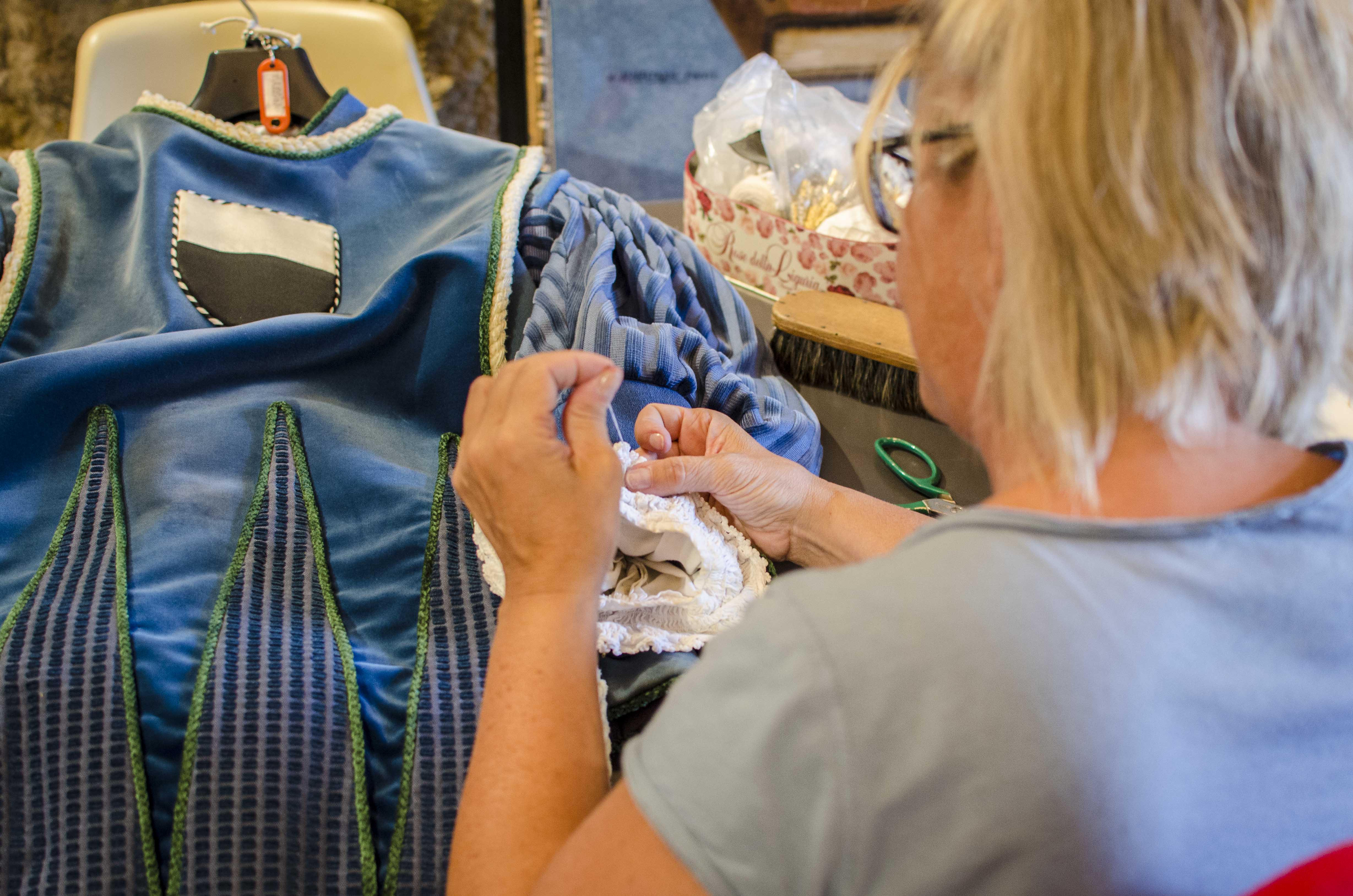
‘Under those costumes, we don’t feel the heat, the honour is the only thing’.
Honoured. This is how people feel when they wear those extraordinary dressed that are part of one of the most exciting Italian cultural representation: the Corteo Storico, Siena’s historical parade. Honoured, it is how we feel as well, to enter the suggestive costume rooms from Piazza del Mercato: a part of the ancient Siena’s salt storehouse, the ‘magazzini del sale’.
The smell of the leather inebriates, the beauty of the costumes fascinates. And here we begin the privileged visit around the enormous effort that supports the greatness of Siena’s historical costume.
It is Tuesday morning, and we are kindly welcomed by Laura Guidolotti and Rita Bianciardi, employed at Siena’s Bursars’ office. Those spaces, just under Palazzo Pubblico, the Town council building, are extremely evocative, full of symbols and historical remembrances.
These rooms are the historical costumes’ treasure chest, used during the Palio’s Historical parade and other occasions as Saint Catherine and Saint Ansano. The beauty is enhanced by the particular time of our visit: few days before the 16 August’s Palio, when excitement becomes tangible. But lets start from the beginning:
What is the Corteo Storico?
The Corteo Storico is an historical parade, a formal and majestic choreography that precedes the Palio, the most famous horse race that is a secular tradition. The parade displays rich medieval costumes, which date back to the time period from 1450 to 1520. The procession goes winding its way round the “Campo” square, celebrating the great splendor of the old Sienese Republic and the importance of the ‘Contrade’, districts into which the town is divided. During the Corte Storico, everyone can re-experience all the ancient tradition so deeply linked to Siena’s present. The parade displays 14 groups, with more than 600 representatives, and 300 are under the town council administration and Laura Guidolotti’s cure, the extraordinary seamstress behind the beauty of these costumes. She is the direct manager of the costume’s custody, from the washing to the seams, everything rigorously handmade.
It is necessary an explanation: the Palio is not a tourist manifestation. The Palio is part of Siena’s natural life and lives in dwellers’ soul, all year long.
The last costume’s renovation goes back to the 2000, following the one of the 1980, of the ’55, ’28 and 1904. This last one is really suggestive, due to the perfect conservation of few samples, that we had the chance to appreciate from few crystal cases in the room. This renovation conserves the precious fabric’s beauty, wisely hand-worked. The excitement of being in this building, surrounded by all this history and magic, being able to admire all the different fabrics and textures is behind words. This parade represents the highest example of the Made in Tuscany’ handcrafts raw materials, as the Colle Val d’Elsa’s and Santa Croce sull’Arno’s leather, Florence’s silk and the Sienese’s precious brocade.
Laura is an extraordinary woman, an expert artisan, constantly inspired by this passion. From her smile and her hands, transpire a true love and dedication towards a job that is not just a job, is a proper mission: to enhance, each time, the beauty of the historical costumes that represent an entire city and centuries of glory. This love transpires from her words as well when we try to better understand how much work lies behind all this, because the Palio is shaped by a thousand of little details and it is extremely important to explore the story behind them.
Laura, it is truly extraordinary the amount of work needed to cure all these costumes and you are the only one concretely behind it. What motivates you?
‘Well, you need a lot of passion, a lot! It is a job of love towards the costumes, the textiles, the tradition and the Palio. It is an extraordinary work and I have a great responsibility. I am not under the spotlight and few people know what I actually do, so it is not acknowledged how it should be. In these rooms there is a constant work, the costumes are complex, from the shoes, to the hats, the belts, the shirt and every single details request my full attention.’
What is the most exciting aspect of your job?
‘The sewing of the Palio, the ‘drappellone’ (ndr the trophy that is to be delivered to the contrada that wins the Palio.) I can’t sleep at night! I am always extremely nervous, as the first time. I feel the adrenaline, the honor and the commitment of such privilege. I work on it 4 days, from 7.30am until 6 in the evening, closed in a room. I use a transparent string and every time it is an extraordinary emotion!
This job represents a unique example of expertise. Have you ever though when you would hand the baton to the next generation?
‘ It is a job where it not enough to be a good seamstress. It is an artisan job that you learn practicing, always supported by an enormous love and dedication to Siena’s historical culture. And you need a certain strength because it is continuous stress for your eyes and hands, but the satisfaction is priceless.
Well, honour and pride. These are the words that remain after this privileged tour behind the scene of Siena’s historical parade. Majestic costumes that are not fancy dresses. It is an extremely serious and formal ritual. The costumes are the representation of something authentically rare and it is everyone’s honour, for all the tourists, to have the chance to experience these costumes, imbued with culture and tradition.



